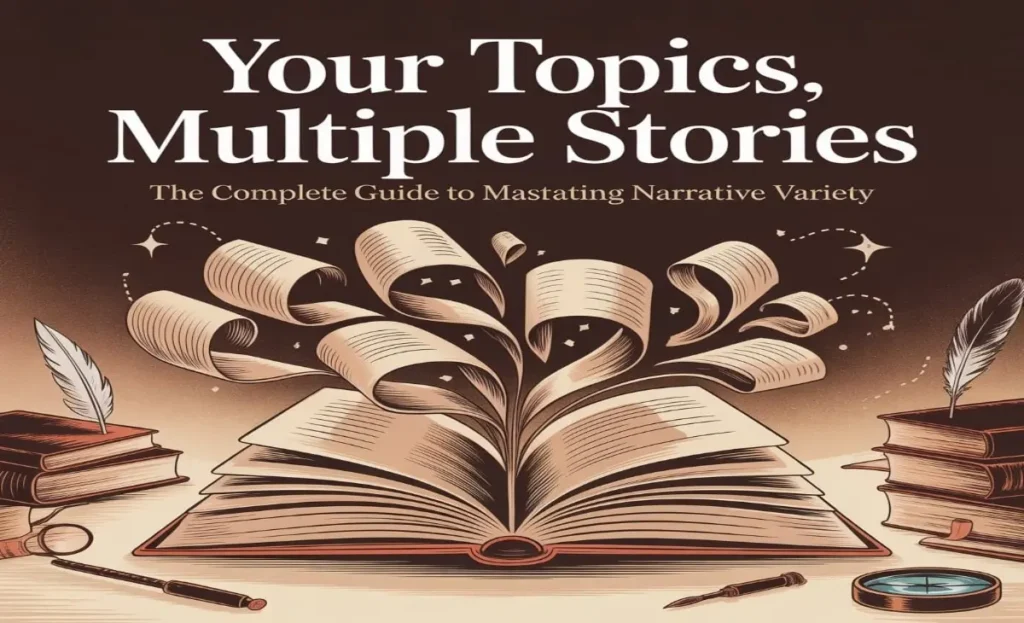Storytelling is fundamental to human connection. Whether it’s in a book, a speech, a marketing campaign, or a personal blog, stories shape how we see the world. But when a single theme or subject is approached in multiple ways, something magical happens—the audience discovers depth, perspective, and new layers of meaning. That’s exactly where the concept of your topics multiple stories comes in.
By exploring different angles, tones, and formats for the same topic, you can appeal to a broader audience, keep content fresh, and ensure your message resonates across different contexts. Whether you are a content creator, business owner, educator, or storyteller at heart, mastering this approach can transform your communication from positive to unforgettable.
What Are Your Topics for Multiple Stories?
At its core, your topics multiple stories means taking one overarching theme and telling it through different narratives, each with its own style, focus, or emotional tone. It’s not about repeating the same thing in different words; it’s about exploring different dimensions of the same idea.
For instance, if the topic is climate change, one story could be a scientist’s journey in researching melting glaciers, another could be a farmer’s struggle with unpredictable seasons, and yet another could be a child’s hopeful dream of a greener planet. Same topic—different voices, different emotions, and different outcomes.
This approach mirrors real life, where a single event is rarely seen from only one perspective. By weaving multiple narratives, you make your topic richer, more relatable, and more memorable.
Explore more insights on our homepage for the latest updates.
Why Your topic’s Multiple Stories Matter
When you tell just one version of a story, you risk limiting your audience’s connection. Different people connect with different kinds of narratives. A factual case study may impress a data-driven reader, but an emotional personal story may resonate more deeply with someone who values lived experiences.
By embracing your topics multiple stories, you create a web of perspectives that engage logic, emotion, and imagination all at once. This approach also increases the lifespan of your content, as you can repurpose and expand ideas without exhausting your audience.
Benefits of Using Your Topics’ Multiple Stories
The advantages of telling multiple stories around a single theme go far beyond creative variety.On top of that, it enhances your credibility, as a broader exploration of the topic shows expertise and thoughtfulness.
Challenges in Crafting Multiple Stories Around One Topic
While rewarding, creating multiple stories for a single subject is not without its hurdles. One common challenge is avoiding redundancy—if each version feels too similar, the audience might disengage. Another challenge lies in maintaining factual accuracy across versions without losing creative expression.
It’s also easy to accidentally create conflicting narratives if you’re not careful with tone and messaging consistency. Overcoming these obstacles requires planning, creativity, and a clear understanding of the core message you want to convey.
How to Identify the Right Angles for Multiple Stories
The key to finding multiple narratives is curiosity. Start by asking: who are the stakeholders in this topic? What emotional tones could be explored—hope, fear, humor, or determination? Which formats could work—interviews, personal essays, expert breakdowns, or fictionalized accounts?
By mapping out the possibilities, you can ensure each story offers something new and valuable. This process is similar to turning a diamond to see its many facets—the beauty lies in the variety.
Crafting Your Topics’ Multiple Stories for Maximum Impact
To craft engaging multiple stories, begin with your core message—the heartbeat of your topic. Then decide the different lenses through which to explore it. This could involve changing the narrator, altering the setting, shifting the focus, or experimenting with the medium.
For example, if your core topic is a product launch, one story could follow the engineers who built it, another could profile the customers who need it, and another could depict a behind-the-scenes journey of its development.
Always ensure each version adds fresh value and keeps the reader or viewer intrigued.
Real-World Examples of Your Topics: Multiple Stories
A wonderful example is the marketing campaign for Nike’s “Just Do It.” The same theme—perseverance—has been told through the lens of professional athletes, everyday runners, disabled athletes, and even young students. Each narrative upholds the brand message, catering to diverse audiences.
In literature, consider how World War II has been depicted in countless novels—from the soldier’s battlefield perspective to the child’s survival story to the nurse’s diary entries. These varied stories make history feel alive, not like a static set of facts.
Step-by-Step Guide to Creating Your Topic’s Multiple Stories
Start by defining your single, clear core topic. Next, brainstorm at least five perspectives or characters connected to it. Map out the emotional tone of each narrative. Choose formats that fit—perhaps a podcast episode, a short video, a blog post, or a photo essay.
After planning, create each version with a focus on freshness. Don’t simply rewrite—reimagine. Once you’ve created the set, publish them strategically, perhaps releasing one per week to build momentum.
Finally, gather feedback and see which stories resonate most with your audience to refine future storytelling efforts.
Maintaining Consistency Across Multiple Stories
Even as you vary perspectives, the voice and brand tone should remain consistent. Your audience should always feel that these stories belong to the same world. That means using a consistent visual style, maintaining alignment with your core values, and avoiding contradictions in factual information.
This balance of diversity and unity is what makes the approach work so well.
Tools and Resources for Managing Multiple Stories
Storyboarding tools like Milanote or Trello can help map out the flow of different stories. Content planning software like Notion or Airtable allows you to track release schedules and maintain quality.
For creative inspiration, platforms like Medium or The New York Times “Opinion” section are filled with examples of how one theme can take many forms.
Multiple Stories in Business and Marketing
In marketing, this technique builds brand depth. A customer testimonial, a behind-the-scenes employee story, and a data-driven case study can all promote the same product while appealing to different audiences. It also gives you more assets to share on social media, keeping engagement high.
YMultiple Stories in Education
Teachers and educators can use multiple narratives to make lessons more engaging. For example, teaching about the moon could involve a scientific explanation, a historical recount of the moon landing, and a fictional story set in a lunar colony.
This approach makes learning dynamic and memorable.
FAQs
What do your topic’s multiple stories mean?
It means telling different narratives based on the same central theme, offering varied perspectives to engage diverse audiences.
Why is creating multiple stories important?
It increases engagement, builds trust, and deepens understanding of your topic.
How do you ensure each story feels fresh?
By changing perspectives, tones, or formats while keeping the core message consistent.
Can multiple stories work in business?
Absolutely—they’re great for marketing, branding, and customer engagement.
Do multiple stories require more content planning?
Yes, careful planning ensures consistency and avoids redundancy.
Is this approach suitable for all industries?
Yes, any field can benefit from telling its core message through multiple perspectives.
Conclusion
Mastering your topics multiple stories is about unlocking the full potential of your subject matter. By offering varied perspectives, you not only expand your reach but also create richer, more memorable connections with your audience. The next time you approach a topic, don’t stop at the first version—explore every possible angle and let your story unfold in its many colors.
If you’re ready to elevate your storytelling game, start brainstorming your next set of narratives today—the world is waiting to hear them.





